Your original jewelry designs receive automatic copyright protection under U.S. law as sculptural works, provided they demonstrate minimal creativity and independent creation. Copyright protects the ornamental elements of your designs but excludes purely functional aspects like clasps. While protection begins immediately upon creation, registering your designs with the U.S. Copyright Office strengthens your legal position and enables statutory damages up to $150,000 for willful infringement. Understanding the full scope of these protections will empower your creative business.
Understanding Copyright Law Basics for Jewelry Creators
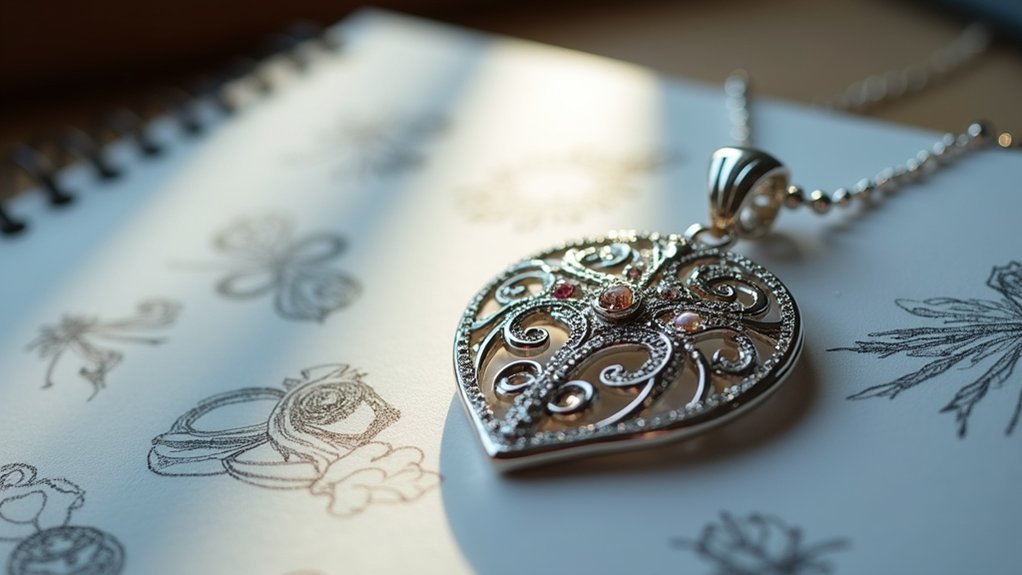
As a jewelry creator, you’ll find that your original designs automatically receive copyright protection the moment you create and fix them in a tangible form, whether that’s a sketch, photograph, or the physical piece itself.
Under Section 101 of the Copyright Act, jewelry designs qualify as visual art, requiring only minimal creativity for eligibility. This means even simple combinations of shapes can earn protection if they’re uniquely arranged.
Simple jewelry designs with minimal creativity can qualify for copyright protection when shapes are uniquely combined and arranged.
However, copyright doesn’t cover functional aspects, basic concepts, or individual geometric shapes like circles or squares. The protection focuses on your creative expression and original artistic elements.
While your copyright exists automatically, obtaining a registration certificate is essential—it’s required to file infringement lawsuits and pursue statutory damages against copycats.
Originality Requirements for Copyrightable Jewelry Designs
While copyright protection kicks in automatically, your jewelry designs must meet specific originality standards to qualify for meaningful legal protection. Your work must be independently created and demonstrate at least minimal creativity. Simply copying existing designs won’t earn you copyright protection, even if you’ve never seen the original piece.
Basic geometric shapes like circles or squares aren’t copyrightable alone, but your unique combinations and arrangements of these elements can qualify. The key lies in how you select and arrange design elements—this must reflect genuine creativity beyond mere mechanical assembly.
Remember that purely functional aspects of jewelry designs can’t receive copyright protection. Copyright law only protects expressive, artistic elements rather than utilitarian features that serve mechanical purposes.
Sculptural Works Classification and Artistic Craftsmanship Standards
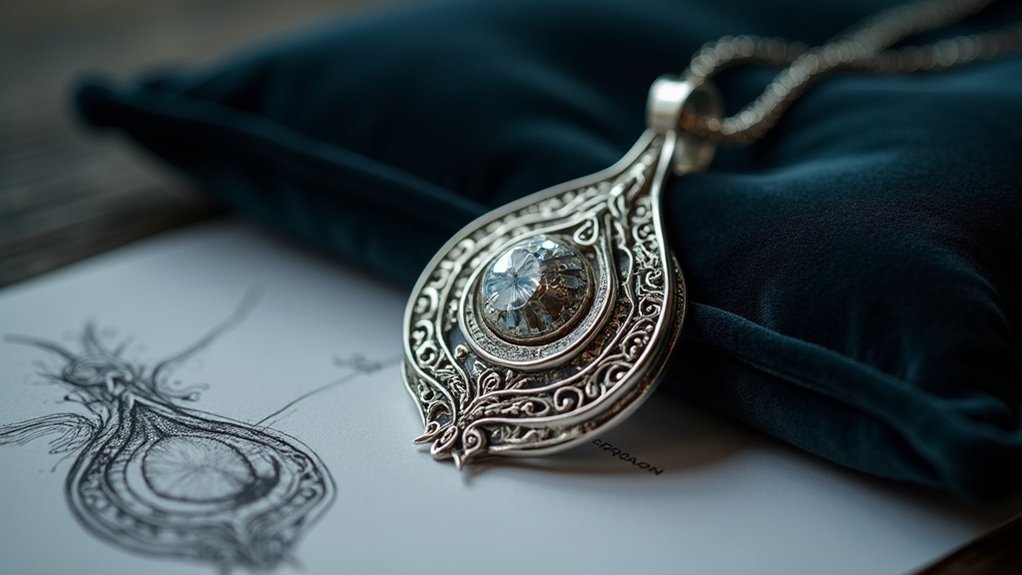
U.S. copyright law classifies jewelry designs as sculptural works, placing them in the same category as three-dimensional art pieces like statues and relief carvings.
This classification provides copyright protection for your original jewelry when it demonstrates artistic merit beyond mere functionality.
To qualify under artistic craftsmanship standards, your designs must meet three key criteria:
- Aesthetic appeal – Your piece should possess visual beauty that stands independently from any practical use.
- Creative expression – You must demonstrate originality and artistic vision in the design elements.
- Artistic merit emphasis – The ornamental features should dominate over mechanical or utilitarian aspects.
Courts evaluate these sculptural works by focusing on artistic elements rather than functional components, ensuring your original jewelry receives protection based on its creative and aesthetic qualities.
Functional Versus Ornamental Design Elements in Copyright Law
When designing jewelry, you must understand that copyright law draws a sharp distinction between functional and ornamental elements, protecting only the artistic aspects of your creations.
Functional elements like clasps, hinges, or basic structural components can’t receive copyright protection because they serve purely utilitarian purposes.
However, the ornamental aspects of your jewelry—the decorative features that make your pieces visually distinctive—are eligible for protection.
Your design must be able to exist independently of its functional elements to qualify for copyright protection.
This means the artistic expression shouldn’t be inseparable from the piece’s practical function.
For example, an ornate pattern on a bracelet’s surface can be protected, but the bracelet’s basic circular shape for fitting around a wrist cannot.
Registration Process and Benefits for Jewelry Design Protection
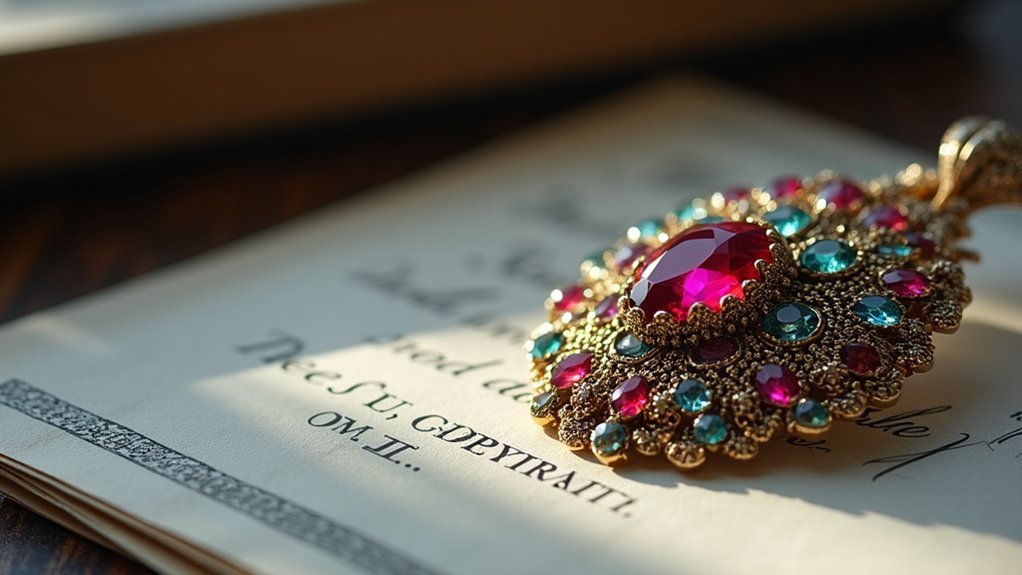
Although copyright protection exists automatically upon creation of your original jewelry design, registering with the U.S. Copyright Office provides essential legal advantages for protecting jewelry.
You’ll need to submit a copyright registration application with photographs of your designs, costing approximately $35 online.
The registration process offers three key benefits:
- Legal enforcement power – Only registered works allow you to pursue statutory damages in court
- Enhanced protection timeline – Registration within three months of publication enables claims up to $150,000 for willful infringement
- Simplified bulk protection – You can register up to ten unpublished designs under one application
Your certificate serves as presumptive proof of copyright validity for five years, making legal disputes easier to resolve and strengthening your position against infringers.
Filing Copyright Infringement Lawsuits Without Prior Registration
You can file a copyright infringement lawsuit for your jewelry designs even without prior registration, though the registration status will greatly impact your available remedies and legal strategy.
Courts have the authority to determine whether your unregistered design meets copyrightability requirements independently of any Copyright Office decisions or rejections.
However, you’ll need to understand how registration timing affects your ability to claim statutory damages and the overall strength of your case in court.
Lawsuit Filing Requirements
While jewelry designers don’t need to register their work with the U.S. Copyright Office to file a copyright infringement lawsuit, understanding the filing requirements guarantees better design protection.
You can pursue legal action even without a registration certificate, though the process involves specific considerations.
Key lawsuit filing requirements include:
- Notice Requirements – If your copyright registration was rejected, you must serve notice to the Register of Copyrights before filing suit.
- Statutory Damages Limitation – You can’t seek statutory damages without completed registration, per Fourth Estate v. Wall-Street.com ruling.
- Court Independence – Courts can determine your work’s copyrightability regardless of Copyright Office decisions.
You’ll still need to prove ownership and infringement, but copyright registration provides a presumption of validity that strengthens your case considerably.
Registration Status Impact
Since copyright protection exists automatically upon creation, you can file infringement lawsuits without prior registration, though your strategic position varies greatly based on your design’s registration status.
Copyright registration provides a presumption of validity in court, considerably strengthening your case. Even if the Copyright Office rejects your application, you can still pursue litigation by serving notice to the Register of Copyrights.
Courts independently assess your design’s copyrightability, regardless of previous registration rejections. However, without registration, you can’t claim statutory damages—only actual damages and profits.
Consider pursuing design patents alongside copyright protection for extensive coverage. While registration isn’t mandatory for filing copyright infringement claims, it offers substantial procedural advantages that can determine your lawsuit’s success and potential recovery amounts.
Court Authority Determination
Federal courts possess broad authority to determine copyrightability independently, allowing judges to evaluate your jewelry design’s originality and creative expression regardless of the Copyright Office’s previous decisions.
You can pursue copyright infringement lawsuits even without prior copyright registration. The Supreme Court’s Fourth Estate ruling confirmed that registration isn’t mandatory for filing claims, though it strengthens your position.
When facing unauthorized use, you’ll need to establish copyright ownership through evidence of creation and originality.
Courts evaluate three critical factors when determining your case:
- Design originality – Your jewelry’s creative elements and unique artistic expression
- Ownership proof – Documentation showing you created the disputed design
- Infringement evidence – Clear demonstration of unauthorized copying or substantial similarity
Even with rejected registration applications, you can notify the Register of Copyrights and proceed with litigation.
Group Registration Options for Multiple Jewelry Pieces
When you’re creating multiple jewelry designs, group registration offers a streamlined approach that can save you both time and money. This option allows jewelry designers to register up to ten unpublished works under a single application, greatly simplifying the process.
You’ll need to verify all pieces are owned by you and haven’t been published before applying. Each design must meet copyright eligibility standards by demonstrating sufficient originality and creativity.
Rather than paying individual fees for each piece, you’ll pay once for the entire group, making protection more cost-effective.
Group registration strengthens your ability to protect your portfolio and assert rights against potential infringers, giving you extensive coverage for multiple designs simultaneously.
Statutory Damages and Remedies for Willful Infringement
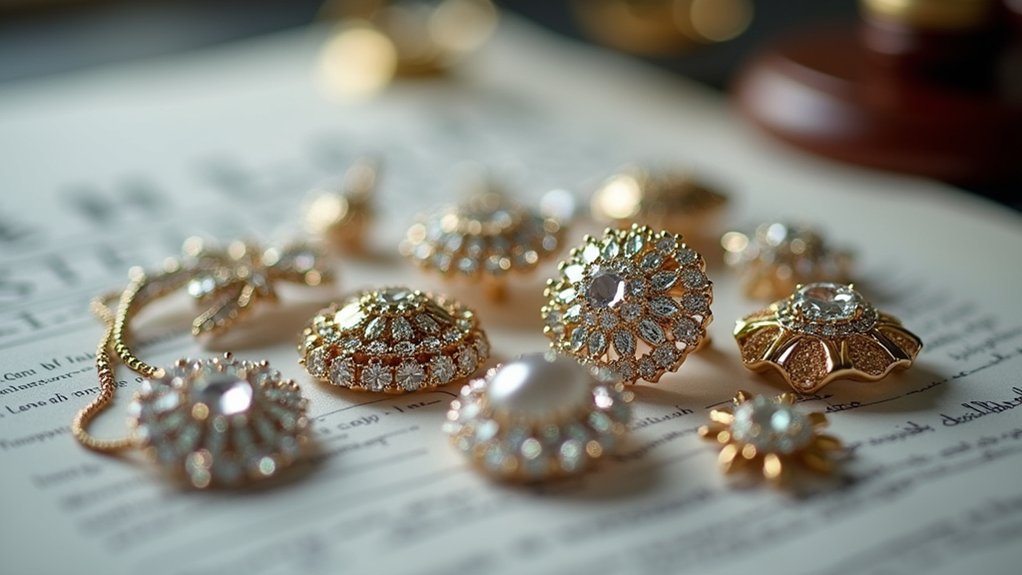
Beyond the administrative benefits of group registration, you’ll want to understand the substantial financial advantages that come with proper copyright protection.
Copyright registration transforms your legal position dramatically when facing infringement, offering powerful remedies that unregistered works simply can’t access.
When your registered jewelry designs are willfully infringed, you can pursue three significant remedies:
- Statutory damages up to $150,000 per work (if registered within three months of publication)
- Actual damages plus any profits the infringer made from your stolen designs
- Attorney’s fees for cases involving pre-registered works
Without copyright registration, you’re limited to actual damages only—no statutory damages or attorney’s fees.
Courts determine statutory damage amounts based on infringement severity and the violator’s intent, making registration essential for meaningful legal protection.
DMCA Takedown Notices for Online Marketplace Protection
Since jewelry designs increasingly face unauthorized copying across online marketplaces like Amazon, Etsy, and eBay, the Digital Millennium Copyright Act (DMCA) provides registered copyright holders with a streamlined mechanism to combat infringement.
Copyright registration enables you to file DMCA takedown notices against platforms hosting infringing listings, forcing their removal to protect your designs.
Your takedown notice must include essential information: contact details, description of the copyrighted work, and a sworn statement affirming infringement.
Online marketplaces must remove infringing content upon receiving valid notices to avoid liability. While false takedown claims can create challenges, you can respond with counternotifications if wrongly accused.
Copyright registration strengthens your legal position when asserting rights against infringers across digital platforms.
Distinguishing Ideas From Expression in Design Copyright
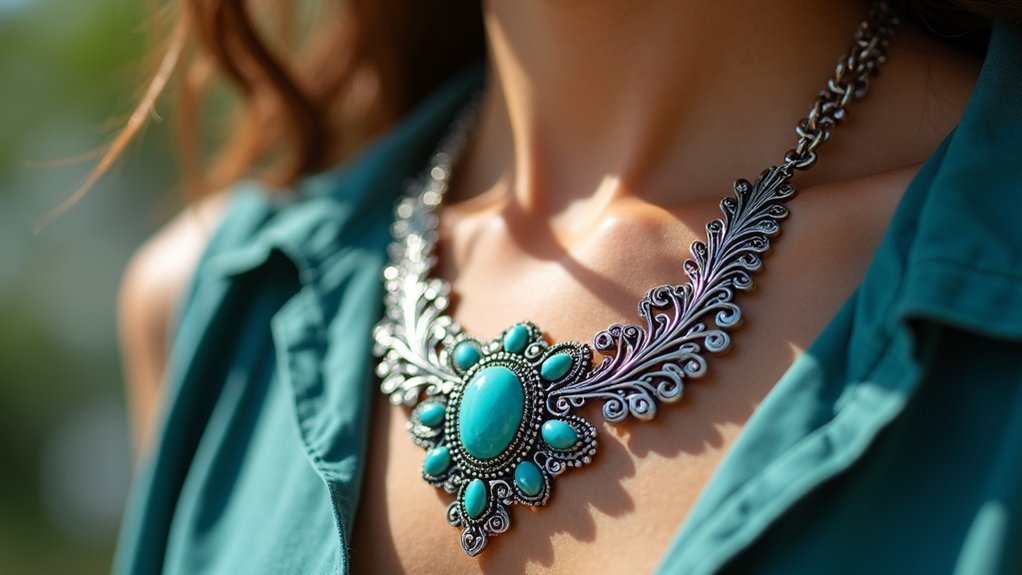
After successfully removing infringing listings through DMCA takedowns, you’ll need to understand what copyright laws actually protect in your jewelry designs.
Copyright protects your specific artistic expression, not the underlying ideas themselves.
Your design must meet these criteria for protection:
- Original combinations – Basic geometric shapes alone won’t qualify, but your unique arrangement of elements can.
- Artistic expression – How you execute an idea (like a bee motif) rather than the concept itself.
- Visual manifestation – The specific way you’ve rendered your creative vision into tangible form.
Understanding this distinction is essential because competitors can use similar ideas without infringing your copyright, as long as their expression differs substantially.
Courts evaluate the visual and aesthetic elements of your original work when determining infringement.
Substantial Similarity Test in Jewelry Infringement Cases
When you’re facing a jewelry copyright dispute, you’ll need to understand how courts apply the substantial similarity test to determine infringement.
You must prove that an ordinary observer would recognize substantial similarities between your design and the alleged copy, focusing on overall impression rather than minor details.
Expert witness testimony becomes essential in these cases, as professionals can analyze complex design elements like shape, pattern, and artistic craftsmanship that laypeople might overlook.
Defining Substantial Similarity
Although copyright protection extends to original jewelry designs, proving infringement requires establishing substantial similarity between your design and the allegedly copied piece.
Courts don’t examine isolated elements but instead focus on the overall impression an ordinary observer would have when comparing the designs.
When determining substantial similarity, courts evaluate three key factors:
- Overall appearance – The general visual impact and aesthetic impression
- Design elements – Shape, pattern, color, and materials used
- Expression vs. idea – How the concept is specifically executed rather than the underlying idea
You’ll need to demonstrate that the accused design captures the essence of your original work.
Small modifications by alleged infringers won’t necessarily avoid infringement if substantial similarity exists.
The test balances protecting your creative rights while allowing legitimate creative competition when a design is created.
Expert Witness Testimony
Expert witnesses play a pivotal role in jewelry infringement cases because they possess the specialized knowledge needed to dissect complex design elements that ordinary observers might miss.
When you’re facing a substantial similarity challenge, expert witness testimony becomes your key to establishing whether designs share enough common elements to constitute infringement. These professionals analyze shape, pattern, color, material, and overall appearance with precision that courts depend on.
You’ll find that expert testimony helps differentiate between legitimate inspiration and actual copying, especially when defendants make minor modifications to existing designs.
Their authoritative perspectives greatly influence jury perceptions, providing clarity on subtle similarities that laypeople can’t readily identify. This specialized testimony often determines your case’s outcome in infringement disputes.
Ordinary Observer Standard
While expert witnesses provide technical analysis in jewelry infringement cases, courts ultimately rely on the Ordinary Observer Standard to determine whether substantial similarity exists between competing designs.
This test asks whether an average person would recognize substantial similarities between your jewelry and another’s design, focusing on overall visual impression rather than technical details.
The ordinary observer standard evaluates three key elements:
- Shape – Overall form and silhouette of the jewelry piece
- Color – Dominant hues and color combinations used
- Ornamentation – Decorative elements and embellishments
This subjective test balances copyright protection against public access to common design ideas.
You can’t claim copyright infringement simply because designs share themes. Courts demonstrated this in Herbert Rosenthal Jewelry Corp. v. Kalpakians, where similar bee motifs weren’t substantially alike enough for infringement.
Design Patents Versus Copyright Protection for Jewelry
When you’re creating original jewelry designs, you’ll need to understand the fundamental differences between design patents and copyright protection to make informed decisions about securing your intellectual property rights.
Design patents protect your jewelry’s ornamental appearance for 15 years from grant date, requiring formal applications with detailed drawings and meeting newness and non-obviousness standards.
Design patents require formal applications with detailed drawings and protect jewelry’s ornamental appearance for exactly 15 years from the grant date.
Copyright protection automatically applies to your original designs as visual art, needing only minimal creativity without formal registration requirements.
You can pursue dual protection since copyright covers aesthetic features while design patents protect shape and surface ornamentation.
Copyright registration strengthens your legal position and enables statutory damages in infringement cases, though automatic protection exists immediately upon creation of your original work.
Trademark Protection for Jewelry Brand Elements and Logos
You’ll need trademark protection to safeguard your jewelry brand’s distinctive elements like logos, names, and symbols that identify your products in the marketplace.
The registration process involves submitting your mark to the USPTO for examination, where they’ll assess its distinctiveness and check for conflicts with existing trademarks.
This protection prevents consumer confusion by ensuring competitors can’t use similar brand elements that might mislead customers about your jewelry’s origin.
Brand Identity Protection
Beyond protecting the artistic elements of your jewelry designs, trademark law offers essential safeguards for the brand identity components that distinguish your business in the marketplace.
While copyright protection covers creative design aspects, trademark protection focuses specifically on your brand’s commercial identity elements.
Your trademark protection encompasses three critical brand components:
- Names and logos – Your business name, product lines, and visual symbols that consumers associate with your jewelry
- Slogans and taglines – Memorable phrases that capture your brand’s essence and marketing message
- Distinctive symbols – Unique marks or emblems that identify your products in the market
Building trademark protection requires consistent commercial use and demonstrating distinctiveness.
Registration typically takes one year but provides indefinite protection through proper maintenance, giving you competitive advantages and deterring infringers from copying your brand identity.
Logo Registration Process
Three essential steps form the foundation of successful logo registration for your jewelry brand.
First, conduct a thorough trademark search to identify potential conflicts with existing marks and avoid application rejection. This preliminary step saves time and money while ensuring your design registration proceeds smoothly.
Second, prepare your trademark registration application with precise logo designs and detailed descriptions of your jewelry goods or services. Your logo must demonstrate distinctiveness rather than merely describing your products, often requiring proof of acquired distinctiveness through commercial use.
Third, maintain your trademark rights through consistent use and timely renewal filings every ten years. While copyright protection covers artistic elements, trademark registration specifically safeguards your brand identity from consumer confusion in the competitive jewelry marketplace.
Consumer Confusion Prevention
When customers can’t distinguish between different jewelry brands, your business loses both sales and reputation.
While copyright protection covers artistic designs, trademark registration safeguards your brand identity through distinctive names, logos, and symbols that set your jewelry apart from competitors.
Your trademark protection strategy should focus on three essential elements:
- Distinctive branding – Create unique logos and names that aren’t merely descriptive of jewelry products.
- Secondary meaning development – Build strong associations between your brand elements and your business through consistent use.
- Active enforcement – Monitor the marketplace and take action against unauthorized use of your trademarks.
Once you’ve established trademark registration, you’ll gain indefinite protection as long as you maintain proper renewals and continue using your marks in commerce, preventing consumer confusion effectively.
Enforcement Strategies and Legal Actions for Design Theft
Discovering someone has copied your jewelry design can feel devastating, but you have several powerful legal tools at your disposal to fight back. Copyright registration strengthens your position greatly, allowing you to pursue legal action and seek statutory damages up to $150,000 for willful violations when registered within three months of publication.
| Strategy | Description |
|---|---|
| DMCA Takedown Notice | Remove infringing listings from online platforms |
| Cease-and-Desist Letter | Formal request to stop unauthorized use |
| Copyright Infringement Lawsuit | Legal action for monetary damages |
| Evidence Documentation | Maintain sketches proving design originality |
You can also submit group registration applications for up to ten unpublished works, reducing protection costs while maintaining detailed creation records for potential disputes.
Frequently Asked Questions
Do Jewelry Designs Have Copyright?
You can copyright your jewelry designs if they’re original artistic expressions. Purely functional pieces aren’t eligible, but creative designs automatically receive protection upon creation, though you’ll need registration for legal enforcement.
How to Protect Jewelry Designs?
You should register your jewelry designs with the U.S. Copyright Office within three months of publication. Consider obtaining design patents for additional protection and regularly monitor the marketplace for unauthorized use.
Are Designs Protected by Copyright?
Yes, your jewelry designs are protected by copyright if they’re original and creative sculptural works. You’ll automatically receive protection upon creation, though registering enhances your legal rights and potential damages against infringers.
How Much Does It Cost to Copyright a Jewelry Design?
You’ll pay $35 to register a single jewelry design online with the U.S. Copyright Office. You can include up to ten unpublished designs in one application, making it cost-effective for multiple pieces.
In Summary
You’ll find that jewelry design protection requires understanding multiple layers of intellectual property law. Copyright protects your original artistic elements, while design patents cover ornamental features and trademarks safeguard your brand identity. You can’t rely on just one protection method—you’ll need a thorough strategy. Document your creative process, register your designs when appropriate, and don’t hesitate to enforce your rights when you discover infringement threatening your business.

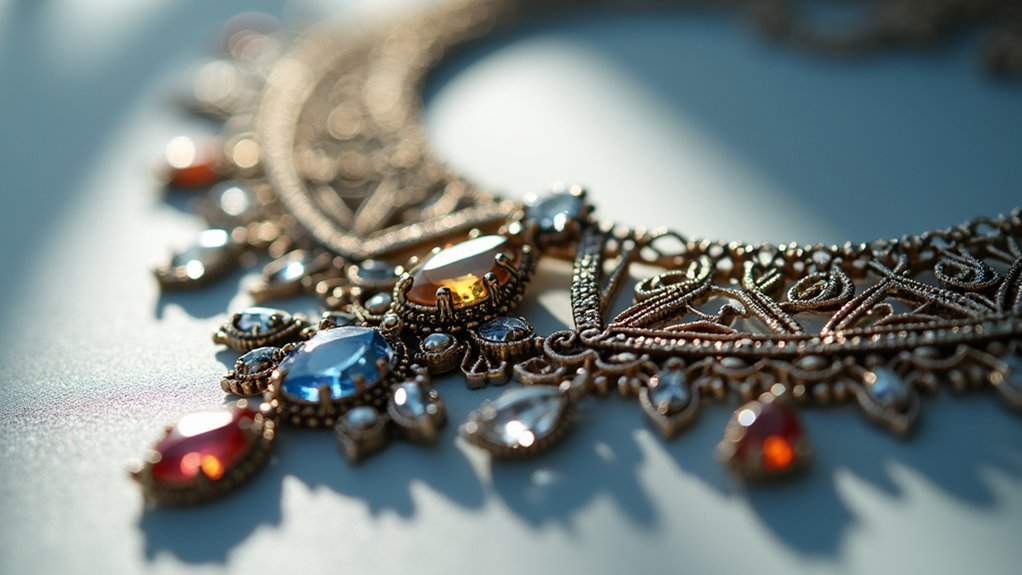



Leave a Reply